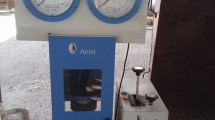Abstract
The abrasion resistance and mechanical properties of concrete containing high-volume fly ash (HVFA) were investigated. Sand (fine aggregate) was replaced with 35, 45, and 55% of Class F fly ash by mass. The water to cement ratio and the workability of mixtures were maintained constant at 0.46 and 55 ± 5 mm respectively. Properties examined were compressive strength, splitting tensile strength, flexural strength, modulus of elasticity and abrasion resistance expressed as depth of wear. Test results indicated that replacement of sand with fly ash enhanced the 28-day compressive strength by 25–41%, splitting tensile strength by 12–21%, flexural strength by 14–17%, and modulus of elasticity by 18–23% depending upon the fly ash content, and showed continuous improvement in mechanical properties up to the ages of 365 days. Replacing fly ash with sand significantly improved the abrasion resistance of concrete at all ages. Strong correlation exists between the abrasion resistance and each of the mechanical properties investigated.












Similar content being viewed by others
References
Ravina D, Mehta PK (1986) Properties of fresh concrete containing large amounts of fly ash. Cem Concr Res 16(2):227–238
Giaccio GM, Malhotra VM (1988) Concrete incorporating high volumes of ASTM Class F fly ash. Cem Concr Aggreg 10(2):88–95
Langley WS, Carette GG, Malhotra VM (1989) Structural concrete incorporating high volumes of ASTM Class F fly ash. ACI Mater J 86(5):507–514
Malhotra VM (1990) Durability of concrete incorporating high-volume of low-calcium (ASTM class F) fly ash. Cem Concr Compos 12(4):271–277
Bilodeau A, Sivasundaram V, Painter KE, Malhotra VM (1994) Durability of concrete incorporating high volumes of fly ash from sources in the USA. ACI Mater J 91(1):3–12
Langley WS, Carette GG, Malhotra VM (1992) Strength development and temperature rise in large concrete blocks containing high volumes of low-calcium (ASTM Class F) fly ash. ACI Mater J 89(2):362–368
Naik TR, Ramme BW, Tews JH (1994) Use of high volumes of class C and class F fly ash in concrete. Cem Concr Aggreg 16(1):12–20
Naik TR, Singh SS, Ramme BW (1998) Mechanical properties and durability of concrete made with blended fly ash. ACI Mater J 95(4):454–462
Poon CS (2000) Study on high strength concrete prepared with large volumes of low-calcium fly ash. Cem Concr Res 30(3):447–455
Maslehuddin M (1989) Effect of sand replacement on the early-age strength gain and long-term corrosion-resisting characteristics of fly ash concrete. ACI Mater J 86(1):58–62
Alasali MM, Malhotra VM (1991) Role of concrete incorporating high volumes of fly ash in controlling expansion due to alkali-aggregate reaction. ACI Mater J 88(2):159–163
Mangat PS, Khatib JM (1995) Influence of fly ash silica fume, and slag on sulfate resistance of concrete. ACI Mater J 92(5):542–552
Liu TC (1981) Abrasion resistance of concrete. ACI J Proc 78(5):341–350
Tikalsky PJ, Carrasquillo PM, Carrasquillo RL (1988) Strength and durability considerations affecting mix proportions of concrete containing fly ash. ACI Mater J 85(6):505–511
Langan BW, Joshi RC, Ward WA (1990) Strength and durability of concrete containing 50 percent Portland cement replacement by fly ash and other materials. Can J Civ Eng 17:19–27
Dhir RK, Hewlett PC, Chan YN (1991) Near-surface characteristics of concrete: abrasion resistance. Mater Struct 24:122–128
Siddique R (2003) Effect of fine aggregate replacement with Class F fly ash on the abrasion resistance of concrete. Cem Concr Res 33:1877–1881
Bilodeau A, Malhotra VM (1992) Concrete incorporating high volumes of ASTM class F fly ashes: mechanical properties and resistance to deicing salt scaling and to chloride-ion penetration, ACI Special Publication ACI SP-132, American Concrete Institute 319–349
Yazici Ş, İnan G (2006) An investigation on the wear resistance of high strength concretes. Wear 260:615–618
Yen T, Hsu TH, Liu YW, Chan SH (2007) Influence of class F fly ash on the abrasion–erosion resistance of high-strength concrete. Constr Build Mater 21:458–463
BIS: 8112-1989, Specifications for 43-Grade Portland cement, Bureau of Indian Standards, New Delhi, India
BIS: 383-1970, Specifications for coarse and fine aggregates from natural sources for concrete, Bureau of Indian Standards, New Delhi, India
BIS: 10262-1982, Recommended guidelines for concrete mix design, Bureau of Indian Standards, New Delhi, India
BIS: 1199-1959, Indian standard methods of sampling and analysis of concrete, Bureau of Indian Standards, New Delhi, India
BIS: 516-1959, Indian standard code of practice- methods of test for strength of concrete, Bureau of Indian Standards, New Delhi, India
BIS: 1237-1980, Method for testing abrasion resistance of concrete, Bureau of Indian Standards, New Delhi, India
Abrams DA (1918) Design of concrete mixtures. Bulletin I Structural Materials Research Laboratory, Lewis Institute, Chicago
Kayali O (2004) Effect of high volume fly ash on the mechanical properties of fiber reinforced concrete. Mater Struct 37:318–327
Neville AM (1995) Properties of concrete, 4th edn. Longman, England, p 660
Fraay ALA, Bijen JM, De Haan YM (1989) The reaction of fly ash in concrete: a critical examination. Cem Concr Res 19:235–246
Author information
Authors and Affiliations
Corresponding author
Rights and permissions
About this article
Cite this article
Siddique, R., Khatib, J.M. Abrasion resistance and mechanical properties of high-volume fly ash concrete. Mater Struct 43, 709–718 (2010). https://doi.org/10.1617/s11527-009-9523-x
Received:
Accepted:
Published:
Issue Date:
DOI: https://doi.org/10.1617/s11527-009-9523-x




